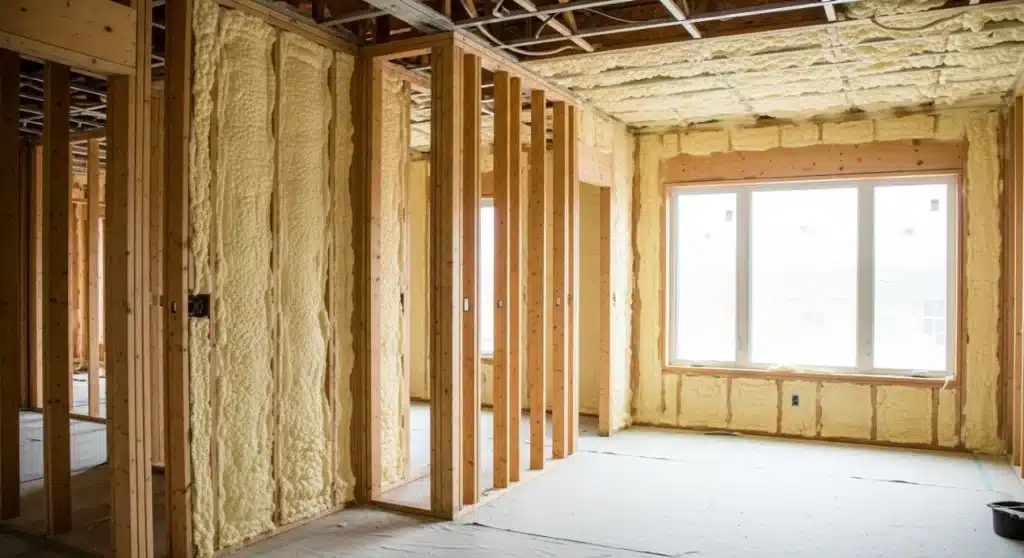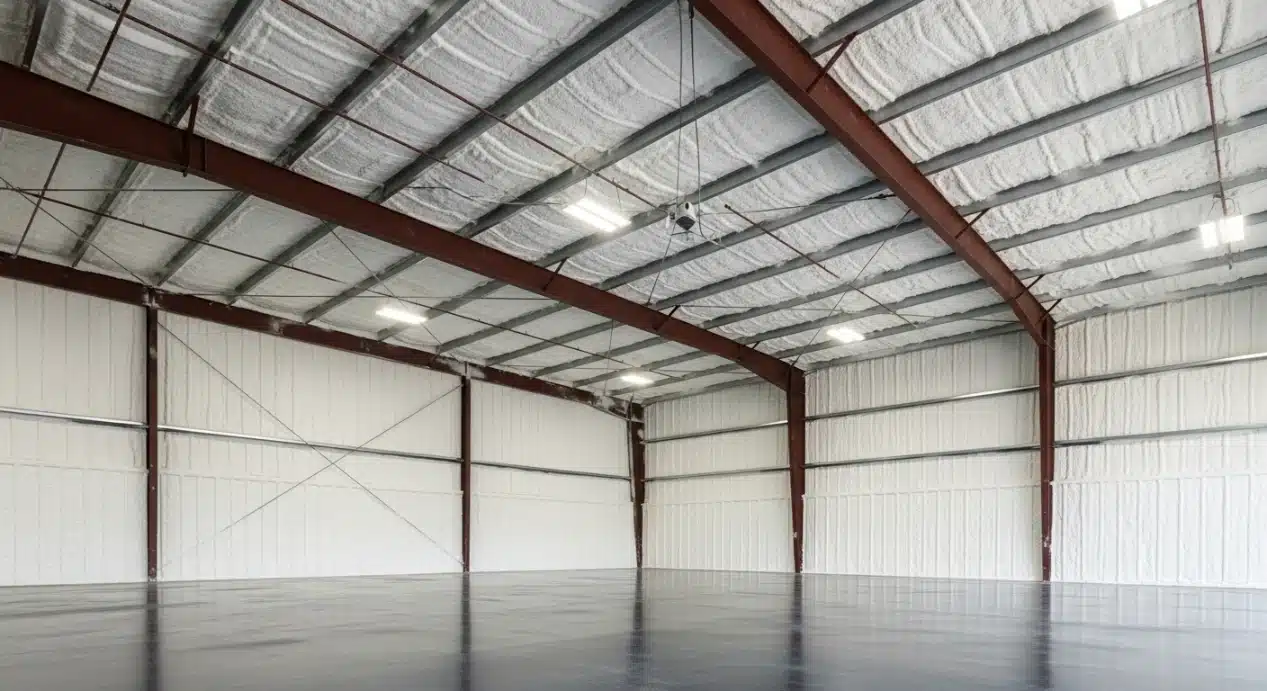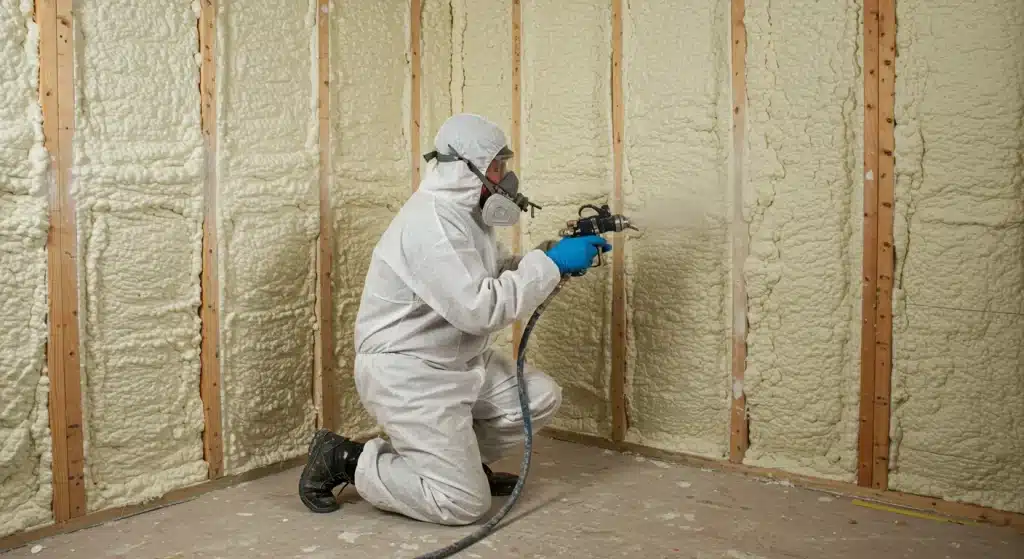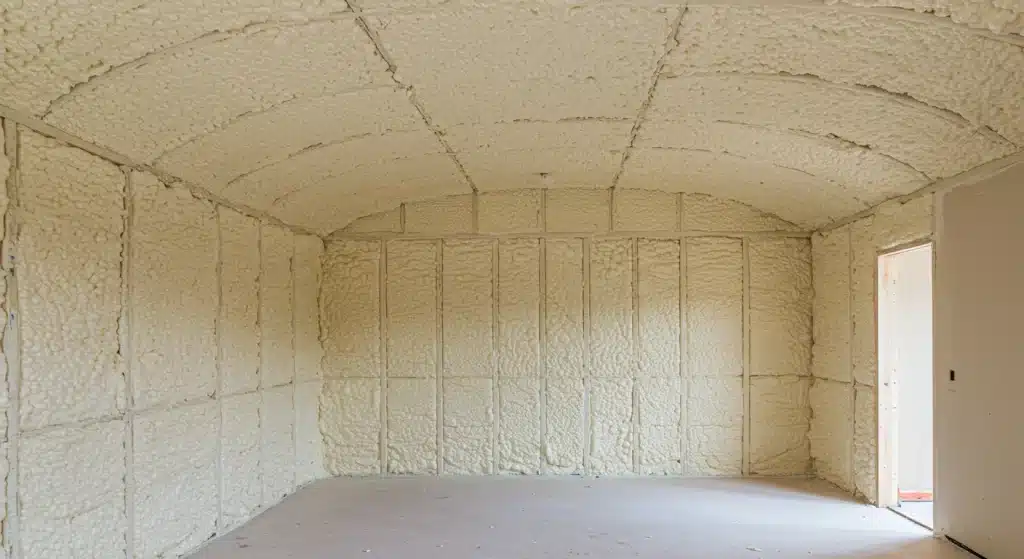Spray foam insulation is a highly effective material for soundproofing homes because it addresses noise in two distinct ways. First, its expansive application creates a complete air seal, blocking the gaps and cracks through which airborne sound travels. Second, the cellular structure of the foam itself absorbs sound waves, dampening vibrations and reducing noise transfer between rooms and from the outside. For homeowners in a vibrant city like Las Vegas, this dual action can make a noticeable difference in creating a quieter, more peaceful living environment.
This article explains the mechanics behind spray foam’s sound-dampening qualities, compares the different types available, and offers practical guidance for its application. The information here is based on extensive field experience in residential and commercial insulation projects, providing a clear look at how this material performs in real-world scenarios.
How Spray Foam Insulation Controls Noise
Noise pollution in residential areas typically comes from two sources: airborne noise and structure-borne (or impact) noise. Airborne noise includes sounds like conversations, traffic, and airplanes. Structure-borne noise is caused by vibrations traveling through a building’s frame, such as footsteps from an upper floor or a door slamming shut.
Spray polyurethane foam (SPF) helps manage both. When professionally installed, it expands to fill every cavity in a wall or ceiling, leaving no air pockets for sound to pass through. This air barrier is particularly effective against airborne noise. The foam’s physical structure also absorbs sound energy.
A material’s ability to block airborne sound is measured by its Sound Transmission Class (STC) rating. According to an analysis from the Spray Polyurethane Foam Alliance, adding just a few inches of spray foam to a wall assembly can significantly increase its STC rating, often improving it by several points. A higher STC rating means less sound passes through the barrier.
Open-Cell vs. Closed-Cell Foam for Soundproofing
The two primary types of spray foam, open-cell and closed-cell, have different properties that make them suitable for different soundproofing applications. Open-cell foam has a softer, more flexible texture because its cells are not fully encapsulated. This structure makes it excellent at absorbing sound waves. Closed-cell foam is much denser and more rigid, which makes it better at blocking sound transmission.
Here is a direct comparison of their soundproofing characteristics:
| Feature | Open-Cell Spray Foam | Closed-Cell Spray Foam |
|---|---|---|
| Primary Function | Sound Absorption (Reduces echo) | Sound Blocking (Stops transmission) |
| Density | Low (Approx. 0.5 lbs/cu. ft.) | High (Approx. 2.0 lbs/cu. ft.) |
| Best For | Interior walls, home theaters, ceilings | Exterior walls, floors, mechanical rooms |
| Frequency Range | Mid to high-frequency sounds (voices, TV) | Low-frequency sounds (traffic, bass) |
| Cost | Lower | Higher |
Bonus Tip: For a media room, open-cell foam is often the preferred choice for interior walls. Its sound-absorbing quality helps reduce reverberation within the room, leading to clearer audio while preventing sound from disturbing the rest of the house.

Practical Applications in a Las Vegas Home
In a city that operates 24/7, controlling exterior noise is a common goal. Las Vegas is home to Harry Reid International Airport, one of the busiest airports in the country. Data from the Bureau of Transportation Statistics consistently places it among the top airports for passenger traffic, which contributes to significant ambient noise in surrounding neighborhoods.
Here are some key areas where spray foam makes a difference:
- Exterior Walls: Applying closed-cell spray foam to exterior walls creates a solid barrier against traffic, aircraft, and neighborhood noise. Its high R-value also provides excellent thermal insulation, a necessity in the Mojave Desert climate.
- Home Offices and Bedrooms: Using open-cell foam in the interior walls surrounding these spaces can create quiet zones, isolating them from household activities. This is especially useful for those who work from home or have different sleep schedules.
- Floors and Ceilings: To reduce structure-borne noise between floors, spray foam can be applied to the floor joists. This dampens the vibrations from footsteps and other impacts, making multi-story homes much quieter.
Things to Consider Before Making a Decision
Before committing to spray foam for soundproofing, it’s important to evaluate a few factors to ensure it’s the right solution for your specific needs.
- Noise Source Identification: Pinpoint the type of noise you want to reduce. Is it the low rumble of traffic or the high-frequency sound of voices from the next room? This will help determine whether open-cell or closed-cell foam is more appropriate.
- Project Scope: Are you building a new home or retrofitting an existing one? Installing spray foam in new construction is straightforward. Adding it to existing walls is more complex and requires an injection method, which may not be suitable for all structures.
- Building Ventilation: Spray foam creates a very tight building envelope. While this is great for energy efficiency and soundproofing, it can also trap indoor air pollutants and moisture. A study from the U.S. Department of Energy highlights the need for proper mechanical ventilation, like a heat recovery ventilator (HRV) or energy recovery ventilator (ERV), in tightly sealed homes to ensure healthy indoor air quality.
Bonus Tip: A professional assessment can help identify the primary sound transmission paths in your home. Sometimes, noise can flank a well-insulated wall through unseen paths like ductwork or floor joists. Addressing these flanking paths is just as important as treating the walls themselves.
Final Considerations
Spray foam insulation stands out as a material that solves two problems at once: it provides top-tier thermal performance while delivering effective sound control. By creating an airtight seal and absorbing sound vibrations, it helps create a more comfortable and serene indoor environment. Before moving forward, evaluate your home’s specific noise challenges, consider the building’s structure, and determine your long-term performance goals.
Get a Professional Evaluation
To properly evaluate these factors and understand how spray foam insulation can best be used in your property for sound control, a detailed assessment is recommended. For a professional consultation, contact Supreme Spray Foam LV to discuss your project. You can reach the team by phone at (702) 904-9895 or via email at [email protected] to schedule an inspection and get tailored advice.
Sources
- Spray Polyurethane Foam Alliance – An industry organization providing technical data and best practices for spray foam applications, including information on its acoustic properties.
- Bureau of Transportation Statistics – A government source for data on the U.S. transportation system, including airport traffic statistics that confirm the high volume of flights at Las Vegas’s Harry Reid International Airport.
- U.S. Department of Energy – A federal agency that offers information on energy efficiency, including guidelines on the importance of ventilation in tightly sealed homes.
FAQS
Can spray foam be installed in existing walls for soundproofing?
Yes, it is possible to insulate existing walls using an injection method. This process involves drilling small holes in the drywall and injecting a slow-rise formula of foam that expands to fill the cavity. It is a specialized job that requires experienced installers to ensure the cavity is filled completely without damaging the wall.
Does spray foam insulation lose its soundproofing ability over time?
No. Unlike some other insulation types that can settle or sag over time, creating gaps for sound to pass through, spray foam is a rigid, permanent material. Once cured, it adheres to the structure and does not compress or lose its shape, ensuring its thermal and acoustic performance remains consistent for the life of the building.
Is open-cell or closed-cell better for a home theater?
As noted earlier, open-cell foam is generally preferred for the interior walls of a home theater. Its soft structure excels at absorbing sound waves, which reduces echo and results in clearer audio. For the theater’s exterior walls, closed-cell foam is a better choice to block outside noise from entering the room.
How does the climate in Las Vegas affect the choice of spray foam?
The hot, dry climate of Las Vegas makes closed-cell spray foam a very practical choice for exterior applications. In addition to its soundproofing capabilities, it acts as an effective air and moisture barrier and has a higher R-value per inch than open-cell foam. This helps keep homes cooler and reduces the strain on air conditioning systems, offering multiple benefits in one product.






